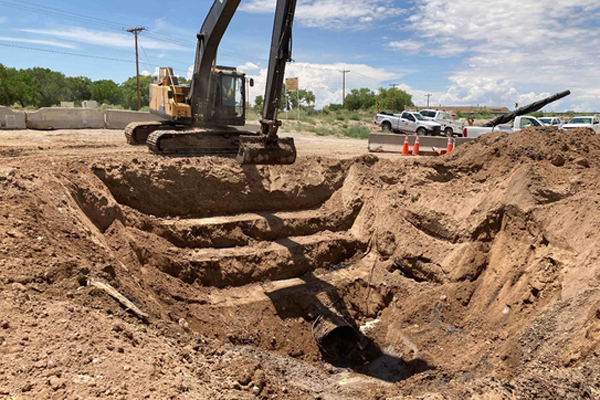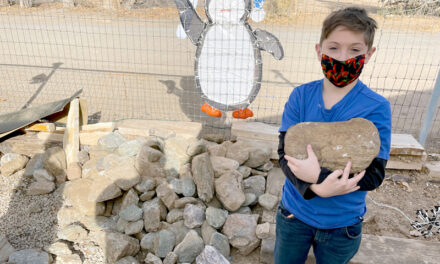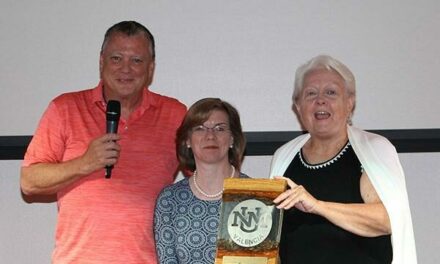It’s hope, prayer and a little bit of duct tape and baling wire that’s holding together 1,200 miles of irrigation infrastructure for the Middle Rio Grande Conservation District, says the agency’s CEO and Chief Engineer Jason Casuga.
“And those of us who grew up in rural communities, we know we can fix a whole lot with baling wire, but eventually it breaks down,” Casuga said.
Major infrastructure failures have put the district in the position of running in a budgeted deficit to the tune of $2 million a year for the last two fiscal years, Casuga said, which has meant pulling funds out of its reserves to keep infrastructure projects moving forward.
While the district has about $7.5 million in its reserves, that doesn’t come within striking distance of addressing the $680 million needed for critical infrastructure projects throughout the district.
To generate more revenue to address those needs, the MRGCD board of directors is considering an increase of 1 mill to property tax assessments within its benefited area.
Current mill rates in the district are 5.0693 for residential properties and 6.334 for nonresidential properties, amounts that haven’t changed since 1998. That was the year the board actually lowered rates from 5.26 and 5.0693, respectively.
“We feel like we’re correcting errors made 20 years ago. They cut rates pretty severely when, realistically, they had needs back then,” Casuga said. “Hindsight is 20/20 and I’m not here to litigate if people did the right thing. We have lots of infrastructure and it has gone well beyond its useful life.”

Courtesy of Middle Rio Grande Conservation District
Temporary repairs being done to the Isleta interior drain at N.M. 147 in 2021
The Corrales Siphon failure is one of the most recent infrastructure problems in the district. The siphon provides irrigation water to farmers in that part of the district, and since the pipe broke last irrigation season, the district has spent $1.7 million on temporary pumping measures.
A permanent fix will cost $9 million, $6.5 million of which the district has been granted by the state’s Water Trust Board. The district will need to come up with $1.2 million in cash as a match, Casuga said, and another $1.3 million from a loan to complete the project.
“We have to have the capital for the cost share and the loan,” the CEO said.
If the 1 mill increase is approved by the board — an action it can only consider every five years per state statute — the use of the projected annual $4.3 million would be bound by resolution to infrastructure capital projects, debit service and grant matches.
“It won’t be allowed for operational costs,” Casuga said. “We will leverage those dollars for more dollars.”
Another large infrastructure cost coming down the irrigation ditch for the district is its part of the El Vado dam rehabilitation project. Although the dam is owned by the federal government, the district is on the hook for 15 percent of the estimated $150 to $200 million rehab total.
“We pay for operational costs since we store water there,” Casuga said. “Through a program we’re a part of — the Bureau of Reclamation’s safety of dams program — since the water the district stores is for agricultural use, it only has to cover 15 percent of the cost.”
The district has 50 years to pay the $22.5 to $30 million for the dam rehab, Casuga said, but it has to have a mechanism to pay.
Stephanie Russo Baca, MRGCD board of directors chairwoman and Valencia County representative, said the mill levy increase will help pay for crucial infrastructure projects which help irrigators throughout the district and in Valencia County.
“There is a lot of funding — $25.4 million — for projects in Valencia County. There are some key projects here, such as the Isleta Dam automation, that could really help district wide,” Russo Baca said. “If it passes, this one mill would generate $4.3 million per year and we could use that to leverage $26 million in grants and $8 million in loans, which would allow the district to take a 51 million bite out of that $175 million over a four-year period.”
After an assessment of district infrastructure needs, staff generated a list of projects totaling $680 million, with 19 priority projects totaling $175 million. Some of those priority projects include a Feeder 3 pump station in Valencia County, which would provide irrigation during drought years, Casuga said, as well as the Isleta Damn gate automation, the Corrales Siphon, Socorro Main Canal channel lining and Belen Highline realignment.
“The board knows inflation is impacting businesses, farms and families. We think proposing this action now will save money in the long run and preserve a way of life that makes living in the valley so rewarding,” Russo Baca said.
If the increase is approved by the board of directors, property owners within the MRGCD will see the new rate on the tax bills sent out in November. According to calculations provided by the district, property owners could seen an increase of $30 to $100 per year for properties valued at $100,000 to $300,000.
The benefited area of the district subject to MRGCD property tax assessments in Valencia County runs north to south along the Rio Grande from one side of the county to the other, and is primarily east of Interstate 25, stretching east to the edge of the llano just beyond La Ladera Road, in Peralta, and La Entrada Road, in Tomé.
The chairwoman said the board will take up the question of the increase at its next meeting at 3 p.m., Monday, May 8, and there will be a specific agenda item for public comment on the mill levy.
“We hope to hear from interested parties at the next board meeting,” she said. “It will be at the beginning of the agenda so people don’t have to sit through the whole meeting.”
The board meeting can be attended in person at the district’s Albuquerque office, 1931 Second St. SW, or by Zoom. Visit the district’s website, mrgcd.com, and click on “Board Meetings” for the Zoom link and information.
More information about the proposed 1 mill increase can also be found on the district website.
MRGCD 2023 Proposed Mill Levy
MRGCD Five Year Budget Forecast
Julia M. Dendinger began working at the VCNB in 2006. She covers Valencia County government, Belen Consolidated Schools and the village of Bosque Farms. She is a member of the Society of Professional Journalists Rio Grande chapter’s board of directors.

















